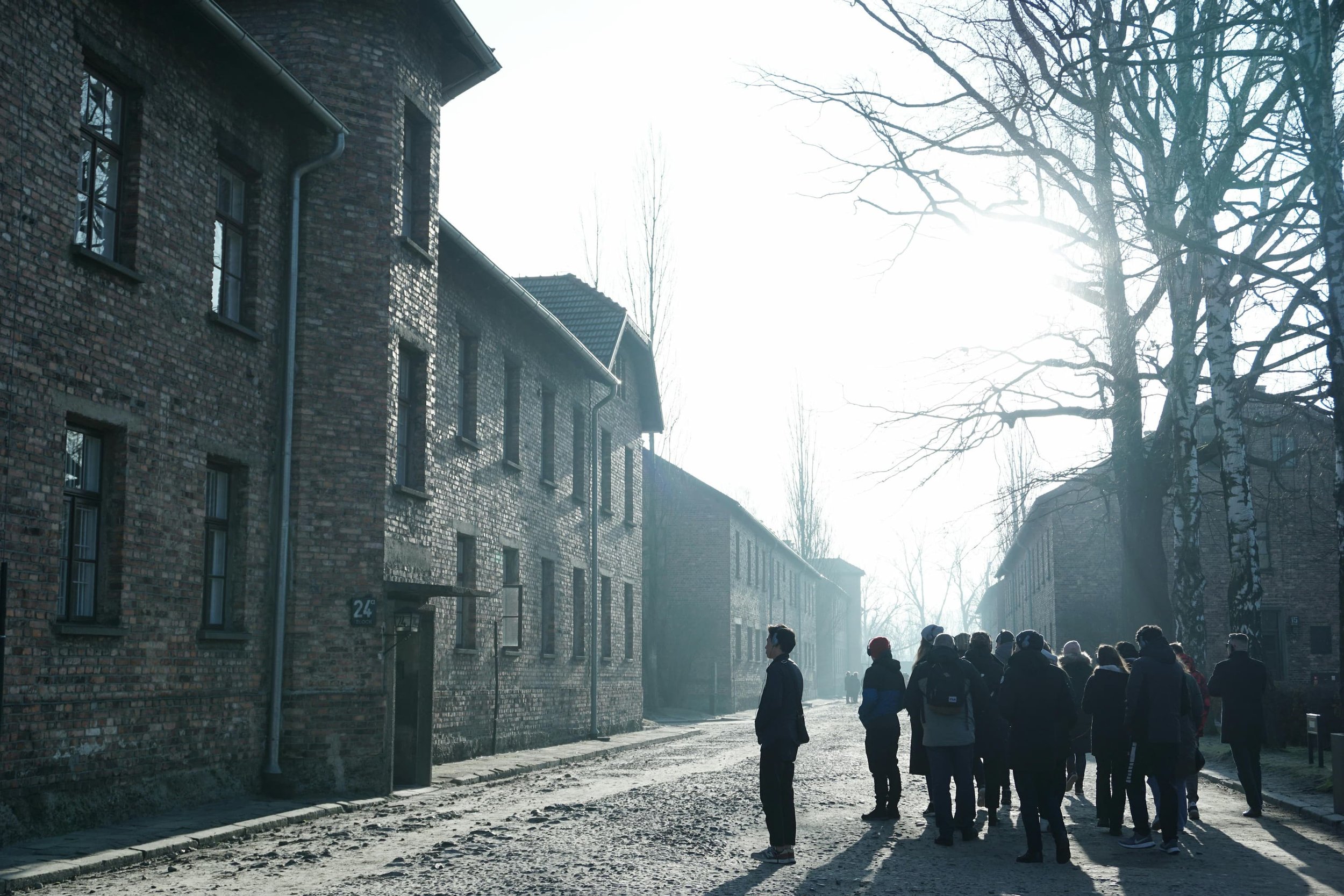Why visiting Auschwitz in winter is a more hauntingly authentic experience.
Freezing… eerie… such an awful experience!
But it is essential to understand the history of Europe.
There’s no such thing as a ‘good’ time to visit Auschwitz.
The weight of what happened there… The murder of over a million people during the Holocaust, hangs in the air year-round.
But in winter, that weight is sharper. The silence is heavier. The cold bites harder.
When I visited Auschwitz-Birkenau in winter, I wasn’t ready for how much the snow added to the atmosphere. Frost clung to the fences. A grey sky hungover endless rows of barracks.
The only sound was my own footsteps. It didn’t feel like sightseeing… It felt like witnessing something we should never forget.
Winter strips everything back. There are fewer crowds. Less noise. Fewer distractions. What’s left is space: for reflection, for grief, for understanding.
Auschwitz-Birkenau is Poland’s most visited dark tourism spot — and with good reason. It offers a global history lesson like no other.
Winter time in Auschwitz adds to the eeriness.
Disclosure: I sometimes use affiliate marketing. This will not cost you anything, but helps with my travel costs. I only recommend companies I use myself.
The Best Auschwitz Tour to take in winter (What I Recommend).
If you’re visiting Auschwitz in winter, taking a guided tour is essential — not just for practical reasons like staying on schedule or avoiding the cold, but because it helps you truly understand what you’re seeing.
👉 This is the Auschwitz-Birkenau tour I personally booked:
Krakow: Auschwitz-Birkenau Guided Tour with Pickup.
It includes hotel pickup and drop-off, skip-the-line access, and an experienced official museum guide.
Why I recommend this specific tour:
Hotel pickup: No stress getting to the site in freezing weather.
Expert guides: All guides are licensed by the Auschwitz Memorial — you’ll get stories, historical context, and answers to difficult questions.
Comfortable transport: Warm vehicle, well-paced itinerary, no standing in long queues.
Emotional support: A good guide knows when to pause, when to let silence speak.
I can't stress this enough: trying to ‘DIY’ Auschwitz in the middle of winter… Without background, guidance, or transport can feel rushed, confusing, and emotionally overwhelming.
I made sure that I chose a reliable tour, as this is an experience that should be done respectfully, and with a very knowledgeable guide.
With over 25,000 reviews and a 4.6/5 rating, this is one of the most trusted tours available.
You can check availability and book the same tour I used here.
A very respectful tour.
What to expect when visiting Auschwitz in Winter.
The cold hits you straight away… Even if you’ve got gloves and a proper coat on.
My breath fogged up in front of me. The wind cuts straight through me, especially out in the open parts of Birkenau where the wooden barracks stretch on and on.
It was bitter, it was bleak… but it felt like it matched the place.
And with fewer crowds, there’s a different atmosphere.
It’s quiet. You’re not being pushed along or waiting behind big groups. You can actually take it all in, the photos, the rooms, the stories. You’ve got space to stop and think.
That eerie silence stuck with me to this day.
A freezing January day.
You can’t be prepared for how cold Poland gets in January, especially not in an open space like this infamous site.
Visiting the iconic Auschwitz in Poland.
How to get to Auschwitz from Krakow in winter.
Auschwitz-Birkenau is about 65 km from Krakow, so it’s a popular day trip… Even in winter.
You’ve got a few options for getting there, depending on your budget, timing, and how much hassle you want.
1. Book a Tour with Pickup (Easiest Option).
Honestly, this is what I did — and I’d 100% do it again.
In winter, with the cold and early darkness, having hotel pickup and drop-off just makes life easier.
No faffing about with buses or figuring out connections in freezing weather. Plus, it guarantees entry, comes with an official guide, and you skip the ticket queues.
👉 This is the exact tour I booked — reliable, well-reviewed, and worth it.
2. By Bus (Cheapest Option).
If you’re on a budget, buses run daily from Krakow to Auschwitz (Oświęcim).
They take about 90 minutes to 2 hours depending on traffic. The good thing is they drop you off close to the entrance.
But heads up — the buses can get packed.
Tickets: ~20 PLN (£4).
Buy at: Krakow MDA bus station (next to Galeria Krakowska).
Stops at: “Muzeum Auschwitz” – 2 mins from the entrance.
Winter tip: No need to pre-book in low season, but double-check timetables just in case.
2. By Train.
You can take a train from Kraków Główny to Oświęcim, but the station is about 2 km from the camp, so you’ll need to walk or grab a taxi at the other end.
It’s not the worst option, but not great in icy weather — especially with limited time.
Tickets: ~15 PLN (£3).
Travel time: 1hr 40min.
Earliest train: 6:44am (if you want to get there for opening time).
Arrival station: Oświęcim.
4. By Taxi or Car.
Got less time and don’t mind spending a bit more? A taxi will get you there in just over an hour.
Taxi cost: Around 175–200 PLN (€35–40) each way.
Bonus: Most hotels can help you arrange a set fare.
Driving yourself? It’s pretty simple — take the A4 motorway and follow signs to Oświęcim. Parking is free.
Heads up: There’s a small toll (~24 PLN) on the A4 each way.
Visiting Auschwitz from other Polish cities?
Warsaw, Wrocław, Łódź and Katowice are examples of where you can book Auschwitz tours from.
Book here.
You can also find a virtual tour here!
Similar signs are throughout Auschwitz.
Auschwitz I to Birkenau Shuttle.
Once you’re at Auschwitz I, make sure you visit Birkenau (Auschwitz II) — it’s where most of the camp’s mass killings happened, and it’s essential to see both.
🚐 Free shuttle runs between the two sites, even in winter.
🚶♂️ You can walk it (~3.5 km), but it’s not fun in freezing weather.
Memorial stone at Auschwitz.
Need to know for your visit to Auschwitz-Birkenau.
Costs.
There is no entry fee to Auschwitz-Birkenau if you want to explore the place at your own leisure.
In a winter visit to Poland’s most visited historical sight, you will have no problems entering this way.
However, during peak summer months (April until October), when the visitor numbers are really high you may be required to book one of the popular Auschwitz tours.
All the museum educators are authorised Auschwitz guides so will make your day a memorable one.
Auschwitz-Birkenau opening hours (2025).
Auschwitz is open almost every day of the year, except:
January 1st (New Year’s Day)
December 25th (Christmas Day)
Easter Sunday (date varies)
2025 opening times by month:
Jan: 8am – 3pm.
Feb: 8am – 4pm.
Mar: 8am – 5pm.
Apr–May: 8am – 6pm.
Jun–Aug: 8am – 7pm.
Sep: 8am – 6pm.
Oct: 8am – 5pm.
Nov: 8am – 3pm.
Dec: 8am – 2pm.
Closing time is 90 minutes after the last entry.
A very frosty day at Auschwitz in Poland.
What to wear & how long to spend at Auschwitz in Winter.
What to wear.
It gets properly cold at Auschwitz in winter… Often below freezing, especially in January and February.
And most of the site is outdoors, with wide open ground and no shelter from the wind. You’ll feel it.
Here’s what I recommend wearing:
Warm coat (ideally windproof and waterproof).
Thick socks and proper shoes or boots – the ground can be wet or icy.
Gloves, scarf, and hat – you’ll need all three.
Layers – thermal base layers or a hoodie under your coat.
Trust me — you don’t want to cut your visit short because you’re frozen stiff.
One of the many rooms where prisoners slept.
How long do you need?
Give yourself enough time to take it in properly. Rushing it doesn’t feel right.
Auschwitz I: 1.5 to 2 hours.
(this is the original camp, with exhibitions, photos, and preserved buildings).Birkenau (Auschwitz II): 1 to 1.5 hours.
(this is the much larger second site, mostly outdoors).Shuttle time between the two sites: allow 15–20 minutes.
So in total, plan for around 3.5 to 4 hours on-site.
If you're on a guided tour, they usually manage this well and keep things flowing. Just don’t plan anything too intense straight after, it's not the kind of place you bounce back from quickly.
Spending some time learning about medical block 10 will add some time to your tour, however, it is well worth it. You will experience the exact location where German doctors performed experiments on prisoners.
Gas chamber at Auschwitz.
Auschwitz in Winter – FAQ.
Is Auschwitz open in the winter?
Yes — Auschwitz-Birkenau is open all year round, including the winter months.
The only days it’s closed are January 1st, December 25th, and Easter Sunday. Winter opening hours are shorter due to daylight (as early as 8am–2pm in December), so check the times before you go.
What should I wear to Auschwitz in the winter?
Warm layers, waterproof shoes or boots, gloves, scarf, and a proper coat.
It’s bitterly cold and you’ll be outside most of the time — especially at Birkenau, which is wide open and exposed to the wind. Dress for comfort, not style.
How long do I need to visit Auschwitz-Birkenau?
About 3.5 to 4 hours total on site. Auschwitz I takes around 1.5 to 2 hours, Birkenau about 1 to 1.5 hours. Add time for the shuttle between the two. Guided tours are usually well-paced for this.
Can I visit Auschwitz without a tour?
Yes — entry is free if you go without a guide, but during peak hours or busy seasons (even some winter days) you may need to pre-book a time slot or join a guided group.
That said, for a first-time visit — especially in winter — I highly recommend going with a guide. You’ll understand far more and avoid transport stress.
👉 This is the Auschwitz tour I booked — and I’d 100% recommend it.
How do I get from Krakow to Auschwitz in winter?
You’ve got a few options:
Guided tour with pickup – easiest and most stress-free in the cold.
Public bus – cheap but can be crowded.
Train – drops you 2km away from the site.
Taxi or rental car – more expensive, but flexible.
Can I take photos at Auschwitz?
Yes, but with sensitivity. Some indoor areas (like certain exhibitions) don’t allow photos — signs will tell you.
Avoid taking selfies or anything that feels disrespectful. This isn’t a tourist spot — it’s a memorial.
The train tracks leading to Auschwitz.
Final thoughts on visiting Auschwitz in winter.
This isn’t a fun day out. It’s not a box to tick.
Visiting Auschwitz — especially in winter — is something that stays with you.
The freezing air, the silence, the sheer scale of Birkenau…
It all sinks deeper when the place is quiet and cold.
You walk where millions once walked. You feel a tiny fraction of the discomfort they faced… And that alone is powerful.
If you're planning a trip to Poland in the colder months, I honestly think winter is the right time to go. It’s more personal. More reflective. And, in a strange way, more respectful.
Just go prepared. Go with an open mind. And if you’re unsure how to plan it, do what I did — book a proper tour, and let someone guide you through the experience.
👉 This is the Auschwitz-Birkenau winter tour I booked
✅ Hotel pickup.
✅ Licensed expert guide.
✅ Comfortable, warm transport.
✅ Over 25,000 positive reviews.
Disclosure: I sometimes use affiliate marketing. This will not cost you anything, but helps with my travel costs. I only recommend companies I use myself.










